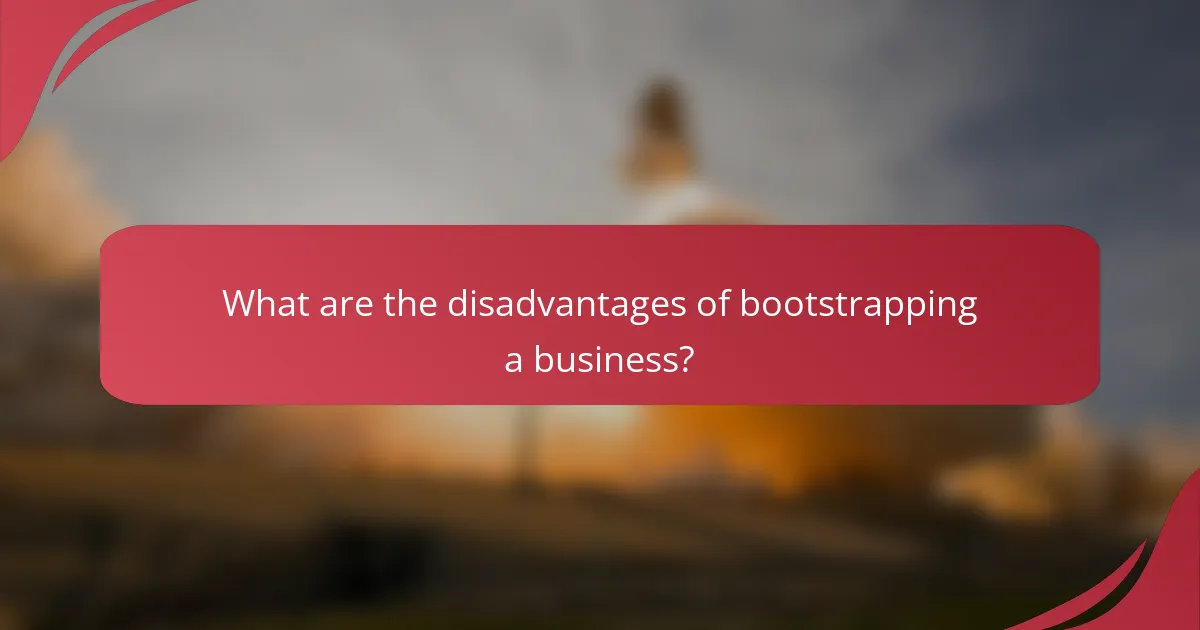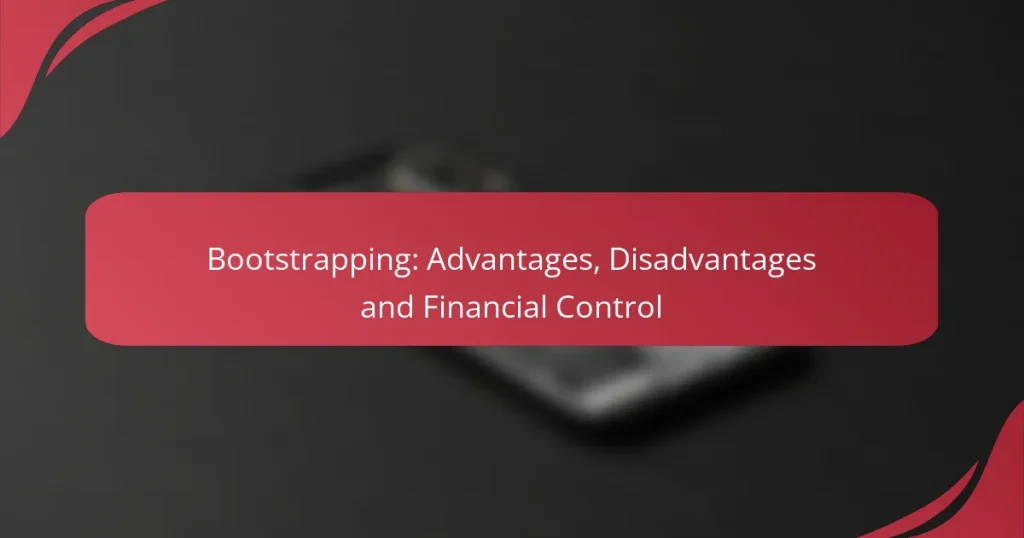Bootstrapping a business enables entrepreneurs to leverage personal savings or revenue generated from their ventures, fostering greater financial control and independence. While this method offers advantages such as decision-making freedom, it also presents challenges like limited resources and increased personal financial risk, which can affect growth and sustainability.

What are the advantages of bootstrapping a business?
Bootstrapping a business allows entrepreneurs to start and grow their ventures using personal savings or revenue generated from the business itself. This approach offers several key benefits, including greater financial control and the ability to make decisions without external pressures.
Full financial control
When bootstrapping, entrepreneurs maintain complete control over their finances, allowing them to allocate resources as they see fit. This autonomy means decisions can be made quickly without needing approval from investors or lenders.
Full financial control also enables business owners to prioritize their spending based on immediate needs and long-term goals, fostering a more sustainable growth strategy. For instance, they can choose to reinvest profits back into the business rather than distributing them to shareholders.
No debt obligations
Bootstrapping eliminates the need for loans or external funding, which means there are no debt obligations to meet. This lack of financial pressure allows business owners to focus on growth without worrying about interest payments or repayment schedules.
By avoiding debt, entrepreneurs can also reduce the risk of financial distress during challenging times. This can be particularly beneficial in volatile markets where cash flow may fluctuate significantly.
Flexibility in decision-making
Bootstrapping provides entrepreneurs with the flexibility to make quick decisions without the constraints imposed by external investors. This agility can be crucial in adapting to market changes or seizing new opportunities as they arise.
For example, a bootstrapped business can pivot its strategy or product offerings more easily than one that relies on external funding, which often comes with specific expectations and timelines. This adaptability can lead to innovative solutions and a stronger market position.
Stronger brand identity
Bootstrapped businesses often develop a unique brand identity that resonates with customers. Without external influences, entrepreneurs can create a brand that reflects their personal values and vision, fostering a deeper connection with their audience.
A strong brand identity can enhance customer loyalty and differentiate a business in a crowded market. For instance, many successful bootstrapped companies emphasize their commitment to quality and customer service, which can lead to positive word-of-mouth and repeat business.
Fostering innovation
Bootstrapping encourages innovation as entrepreneurs are often required to find creative solutions to challenges. Limited resources can drive businesses to think outside the box and develop unique products or services that stand out in the marketplace.
This innovative spirit can lead to the development of niche markets or specialized offerings that larger, more funded competitors may overlook. By leveraging their agility, bootstrapped businesses can quickly test and refine new ideas, leading to sustainable growth.

What are the disadvantages of bootstrapping a business?
Bootstrapping a business can lead to several disadvantages that may hinder growth and sustainability. Key drawbacks include limited resources, slower growth potential, higher personal financial risk, and difficulty in scaling operations.
Limited resources
When bootstrapping, entrepreneurs often rely on personal savings or revenue generated from initial sales, which can restrict available funds. This limitation can impact the ability to invest in essential areas such as marketing, technology, or hiring skilled employees.
For example, a startup may struggle to launch a comprehensive marketing campaign due to budget constraints, resulting in reduced visibility and slower customer acquisition. Entrepreneurs should prioritize resource allocation and seek creative solutions to maximize their limited funds.
Slower growth potential
Bootstrapped businesses typically experience slower growth compared to those that secure external funding. Without substantial capital, scaling operations or expanding product lines can take significantly longer.
This gradual growth can be detrimental in competitive markets where speed is crucial. Entrepreneurs should set realistic growth expectations and focus on sustainable strategies to build their customer base over time.
Higher personal financial risk
Bootstrapping often means that entrepreneurs invest their personal finances into the business, which increases their financial exposure. If the business fails, they may face significant personal losses, including savings or even debt.
To mitigate this risk, it’s essential for entrepreneurs to maintain a personal budget and avoid overextending themselves financially. Establishing a safety net or seeking alternative funding options can help protect personal finances.
Difficulty in scaling
Scaling a bootstrapped business can be challenging due to limited resources and funding. Entrepreneurs may find it hard to hire additional staff, invest in technology, or expand into new markets without sufficient capital.
To address these challenges, businesses can consider strategic partnerships, outsourcing certain functions, or leveraging technology to improve efficiency. Planning for gradual scaling can help ensure sustainable growth while managing financial constraints.

How does bootstrapping compare to venture capital funding?
Bootstrapping involves using personal savings or revenue from the business to fund growth, while venture capital funding relies on external investors providing capital in exchange for equity. Each approach has distinct advantages and disadvantages that impact ownership, control, and access to funds.
Ownership retention
One of the primary advantages of bootstrapping is the ability to retain full ownership of your business. Since you are not giving away equity to investors, you maintain complete control over decision-making and profit distribution. This can be particularly beneficial in the early stages when establishing your vision and brand identity is crucial.
In contrast, venture capital funding typically requires giving up a portion of ownership, which can dilute your stake and influence. This can lead to conflicts in vision and strategy as investors may have different priorities than the original founders.
Control over business direction
Bootstrapping allows entrepreneurs to steer their business in the direction they choose without external pressure. This autonomy can foster innovation and enable quick pivots in response to market changes. Founders can prioritize long-term goals over short-term returns, which is often a challenge with venture capitalists who expect rapid growth.
On the other hand, venture capitalists often impose conditions on their investment, including milestones and performance metrics. This can limit the founder’s ability to make independent decisions, as they may need to align their strategies with investor expectations.
Funding speed and accessibility
Bootstrapping can provide immediate access to funds, especially if you are using personal savings or reinvesting profits. This can lead to faster decision-making and implementation, as there are no lengthy negotiations or due diligence processes involved. However, the amount of capital available may be limited, which can restrict growth potential.
Venture capital funding, while potentially offering larger sums of money, often involves a lengthy process of pitching, negotiations, and due diligence. It may take weeks or months to secure funding, which can delay critical business initiatives. Additionally, the competitive nature of securing venture capital can make it less accessible for many startups.

What financial controls are essential for bootstrapped businesses?
Bootstrapped businesses must prioritize financial controls that ensure sustainability and growth without external funding. Key controls include effective cash flow management, disciplined budgeting practices, and reliable expense tracking tools.
Cash flow management
Cash flow management is critical for bootstrapped businesses to maintain liquidity and operational stability. It involves monitoring the inflow and outflow of cash to ensure that the business can meet its financial obligations.
To manage cash flow effectively, business owners should regularly forecast cash needs, ideally on a monthly basis. This helps identify potential shortfalls and allows for timely adjustments, such as delaying expenses or accelerating receivables.
Budgeting practices
Implementing strong budgeting practices helps bootstrapped businesses allocate resources efficiently and avoid overspending. A well-structured budget should outline expected revenues and expenses, providing a roadmap for financial decision-making.
Business owners should consider using a zero-based budgeting approach, where every expense must be justified for each new period. This method can help eliminate unnecessary costs and ensure that funds are directed toward the most impactful areas of the business.
Expense tracking tools
Expense tracking tools are essential for maintaining financial control in a bootstrapped business. These tools help monitor spending in real-time, allowing for quick identification of any discrepancies or unexpected costs.
Popular expense tracking solutions include software like QuickBooks, Expensify, or even simple spreadsheets. Choosing the right tool depends on the business size and complexity, but it’s crucial to ensure that all expenses are recorded accurately and categorized properly to facilitate better financial analysis.

What are the best practices for bootstrapping in e-commerce?
Effective bootstrapping in e-commerce involves leveraging cost-effective strategies to launch and grow a business without external funding. Key practices include utilizing low-cost marketing, adopting dropshipping models, and building a strong online presence.
Utilizing low-cost marketing strategies
Low-cost marketing strategies are essential for bootstrapped e-commerce businesses to reach potential customers without overspending. Consider using social media platforms, content marketing, and email campaigns, which can be highly effective and often free or low-cost.
Engaging with your audience through organic social media posts or creating valuable blog content can help build brand awareness. Focus on targeting niche markets and using SEO techniques to drive traffic to your site without significant advertising costs.
Leveraging dropshipping models
Dropshipping allows e-commerce entrepreneurs to sell products without holding inventory, reducing upfront costs. By partnering with suppliers who ship directly to customers, you can focus on marketing and customer service instead of logistics.
This model is particularly beneficial for testing new products or markets with minimal financial risk. However, ensure you choose reliable suppliers to maintain product quality and customer satisfaction.
Building a strong online presence
A robust online presence is crucial for attracting and retaining customers in a competitive e-commerce landscape. Start by creating a user-friendly website that showcases your products effectively and provides a seamless shopping experience.
Invest time in optimizing your site for search engines and consider utilizing platforms like Shopify or WooCommerce, which offer affordable solutions for e-commerce. Regularly update your content and engage with customers through social media to foster loyalty and encourage repeat business.

